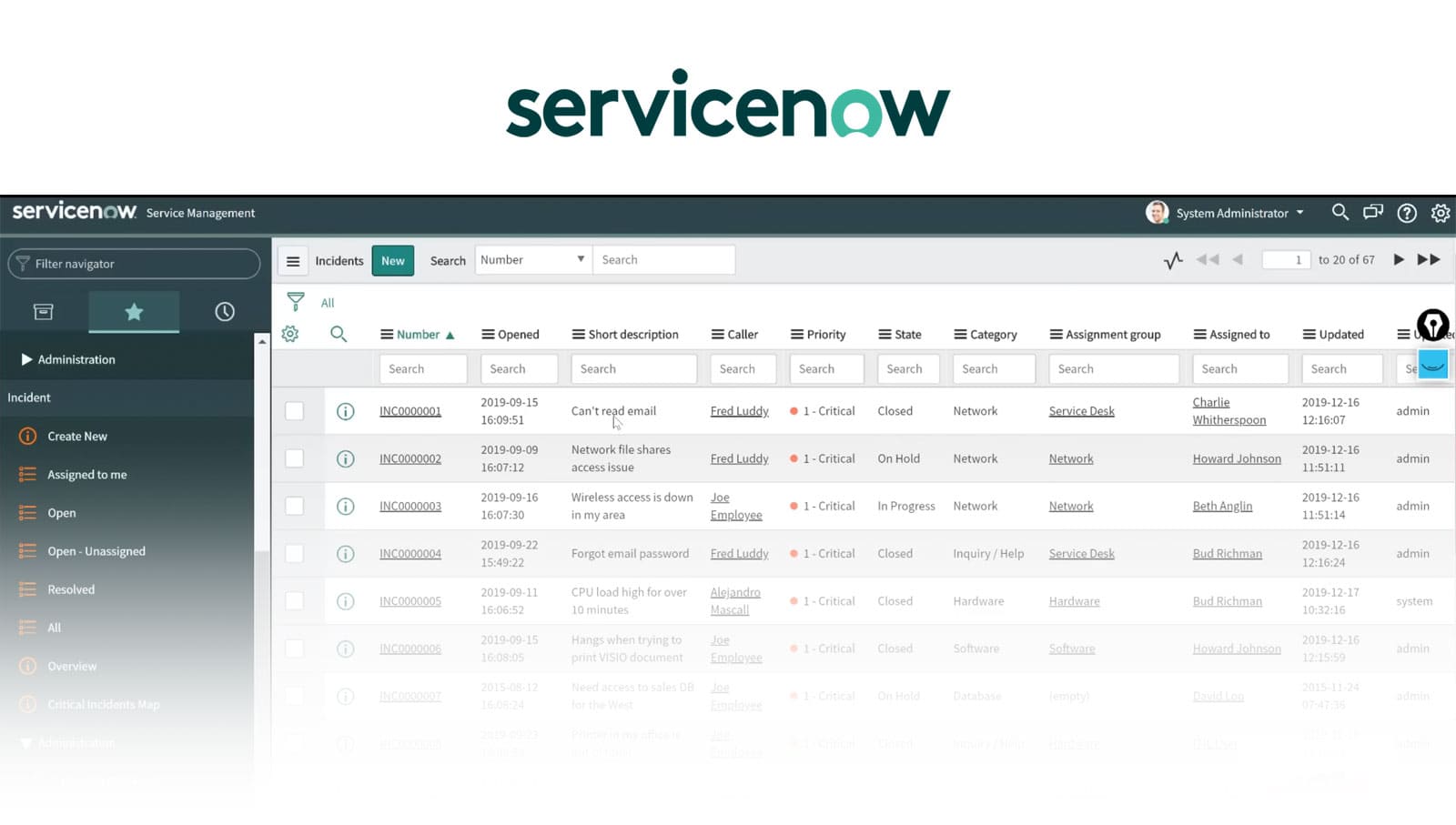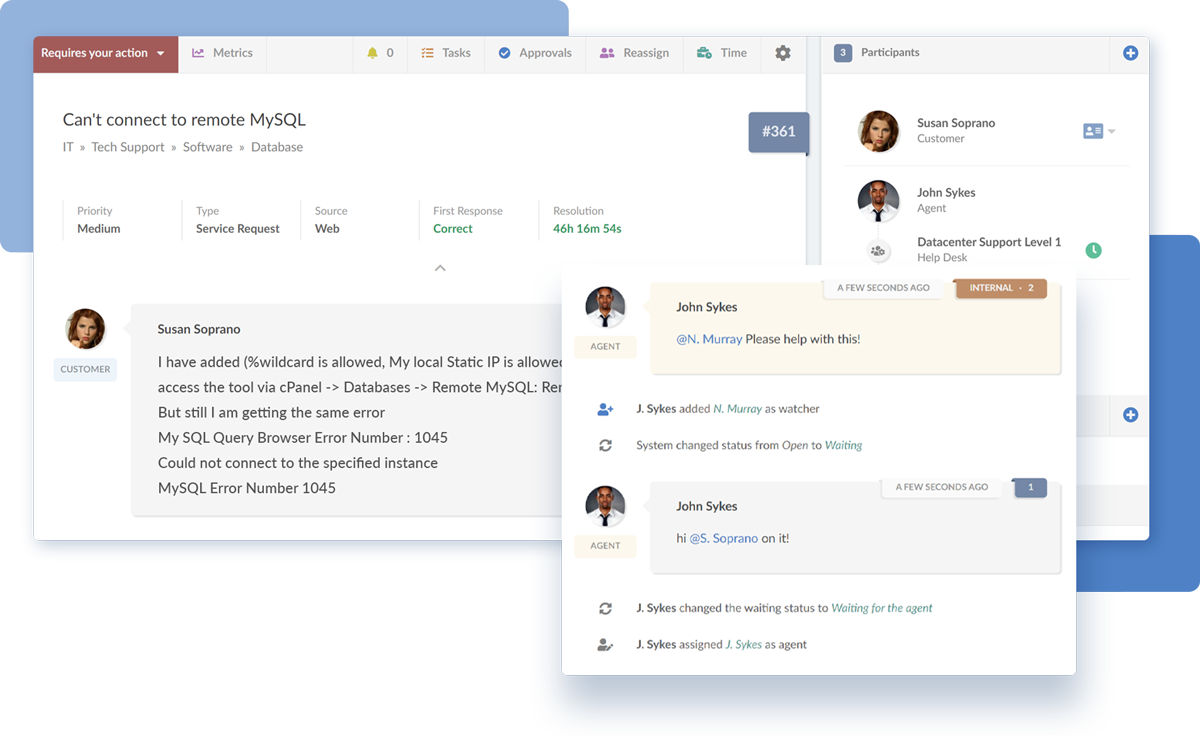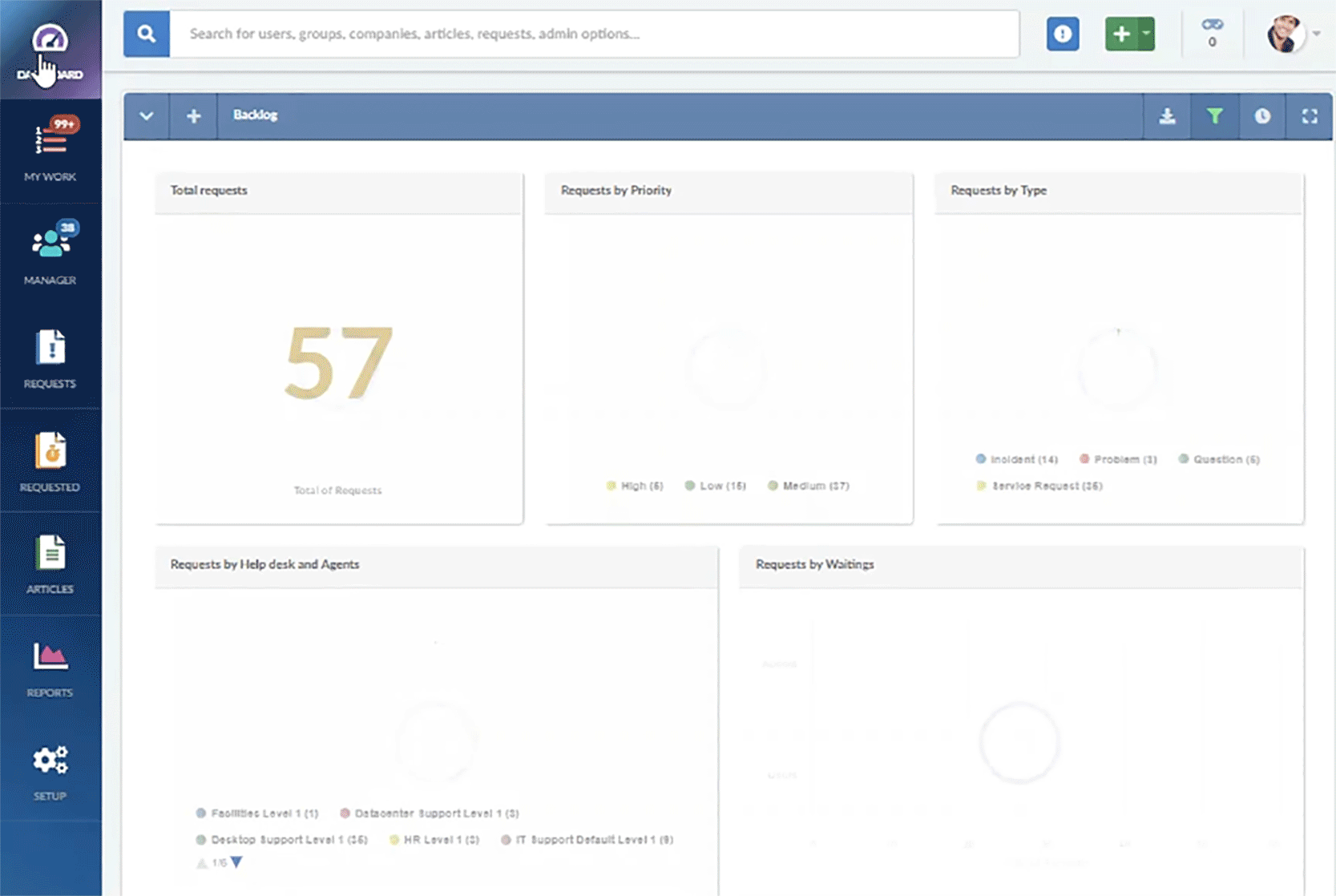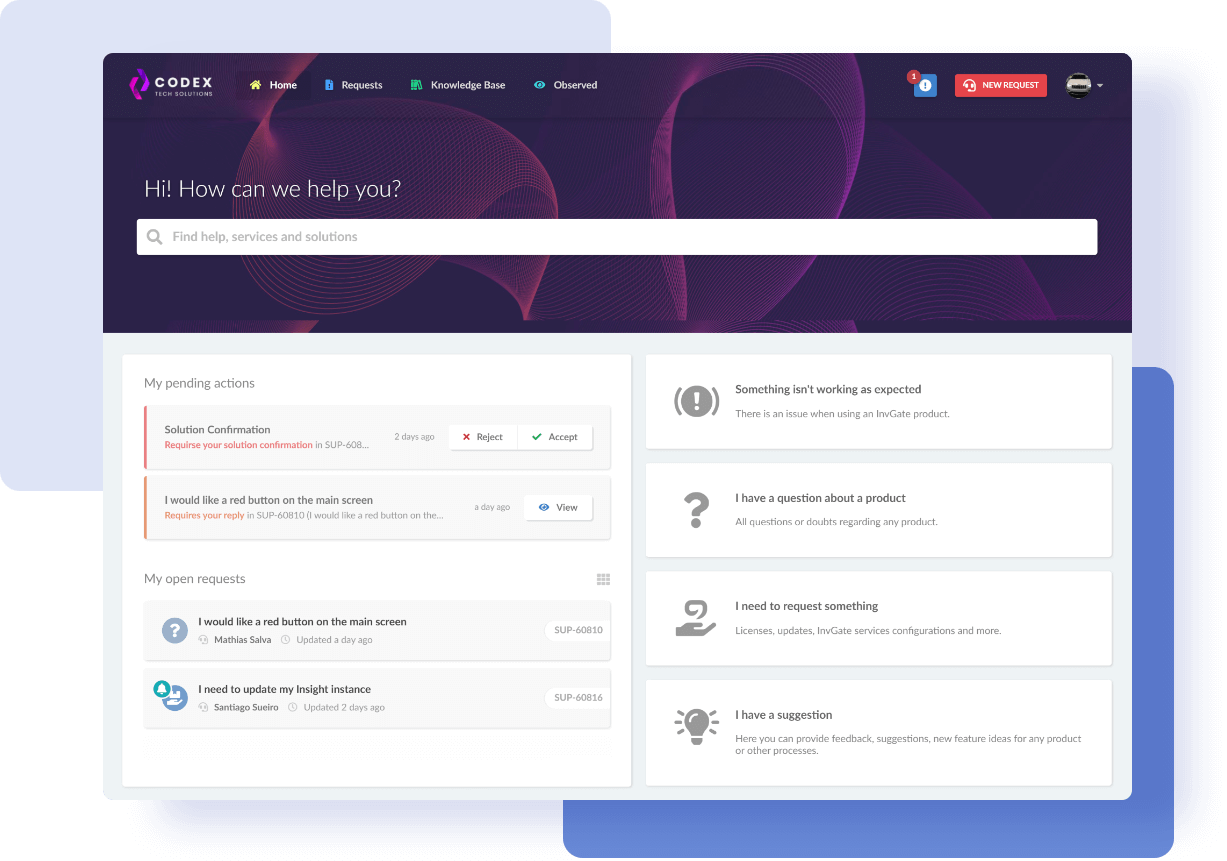Are you considering choosing between Aranda Service Management vs. ServiceNow to enhance your IT Service Management (ITSM) operations? Making the right choice can significantly impact your organization's efficiency and service delivery.
In this blog post, we’ll delve into Aranda Service Management and ServiceNow's key aspects, providing insights to aid your comparison. However, we won't stop there. We’ll also introduce you to an alternative solution that stands out amidst this competition: InvGate Service Management. This solution goes beyond traditional service desk software, prioritizing digital transformation, streamlined functionalities, and an opportunity to elevate your IT operations to new heights.
Join us on this ITSM tools comparison and find the perfect fit to transform your IT operations.

Table of contents
- TL;DR
- What is Aranda Service Management?
- What is ServiceNow?
- Considering InvGate Service Management as an ITSM solution alternative
TL;DR
- Aranda Service Management offers a unified web console and flexible installation options while ensuring rapid implementation with default configurations. It also provides Spanish support in Latin America. Nonetheless, its absence of reviews on major platforms leaves specific user criticism unidentified.
- ServiceNow stands out for ongoing improvements and robust integrations, yet encounters hurdles in high licensing costs, a steep learning curve, workflow customization, and implementation delays.
- InvGate Service Management, on the other hand, provides streamlined ITSM setup, flexible deployment, robust ticketing and incident management, and self-service capabilities, emphasizing cost-effectiveness and innovation.
We tried to be as thorough as possible, but if you don't have enough time to read it through and through, here's (another) TL;DR: InvGate Service Management can do everything we say here, and you can test it right away for free for 30 days.
Most looked-at features by buyers
When potential buyers assess options for managing IT services, they concentrate on specific features that suit their organization's needs. Having a good understanding of these desired features is crucial for making well-informed decisions.
Let's explore the main factors that prospective buyers typically take into account when comparing IT Service Management tools.
- Ticket Management solution - Buyers recognize the importance of a comprehensive system for managing customer inquiries and support requests. This feature allows for efficient tracking, assignment, and resolution of tickets within the help desk software.
- Customization and flexibility - Buyers look for software solutions that can be customized to align with their business needs. Having flexibility in tailoring the platform to unique workflows and processes enhances user satisfaction and overall effectiveness.
- Insightful reporting - Buyers seek help desk software with robust reporting tools like dashboards and reports to gain valuable insights into their IT operations and performance. These data-driven insights facilitate informed decision-making and continuous service improvement.
- Scalability - Organizations with evolving needs prioritize solutions that can adapt to their growth and accommodate customization. The software should allow the creation of custom fields, workflows, and extensions/plugins to meet unique business requirements.
- Pricing and support - Buyers consider the solution's cost-effectiveness, including licensing models, subscription plans, and additional costs for features or users. The availability of reliable customer support, comprehensive documentation, and accessible training resources also plays a significant role in the decision-making process.
- ITIL compliance - Many organizations prioritize solutions that adhere to ITIL best practices. Buyers may focus on solutions that support ITIL processes such as Incident Management, Problem Management, Change Management, and Asset Management.
- User experience and interface - Buyers prioritize platforms that are user-friendly, with intuitive interfaces that encourage users to adopt the system and enhance productivity. Mobile accessibility is also important, especially for remote or mobile workforces organizations.
- Support automation and Workflow Management - Buyers actively seek software solutions that offer automation capabilities to streamline routine tasks like ticket routing, approvals, and escalations. These automation features contribute to increased efficiency and productivity.
- Self-service portal and knowledge base - Buyers highly value having a self-service portal that enables end-users to independently resolve common issues and access relevant information without needing direct assistance.
- Optimized IT service catalog - Organizations often require a centralized platform for users to request specific IT services or resources. This streamlined IT service catalog simplifies service requests, improves visibility, and assists in effective Service Delivery Management.
- Seamless integration capabilities - Integration with other systems and applications is a critical requirement for buyers to ensure smooth data flow and process automation. Integrating with existing tools (particularly ITAM tools) and platforms is highly valued for improved efficiency and a unified user experience.
- Efficient IT Asset Management - Users prioritize software that offers strong capabilities for managing IT assets, including accurate inventories and optimized resource utilization within their organizations.
What is Aranda Service Management?
Aranda Software, a Colombian company specializing in IT services and Infrastructure Management, offers its primary software solution, Aranda Service Management. This comprehensive software is specifically designed to assist businesses in efficiently managing various processes and providing support for different types of cases. With Aranda Service Management, businesses can effectively handle requests, incidents, problems, and changes, all through a centralized console.
In addition to Aranda Service Management, the company offers several other software products that adhere to ITIL's best practices. One of these products is Aranda Asset Management, which aims to bring value to businesses in the Latin American region. With a strong local presence in 10 Latin American countries, Aranda Software offers flexible licensing options, including Cloud, On-premise, Hybrid, and SaaS models.
What users like from Aranda Service Management
As of the time of writing, the company's website highlights the following benefits. However, there are no accessible reviews on popular platforms such as Gartner, G2, or Capterra, which could provide additional insights from user perspectives.
- Quick implementation - The platform aims to expedite the implementation process by providing default configurations, templates, and models. These resources are readily available to accelerate the configuration process and ensure a speedy setup.
- On-premise/Cloud options - Users have the freedom to choose between different installation options based on their infrastructure requirements and organizational preferences. They can opt for either an on-premise or cloud-based deployment.
- Unified web console - The platform offers a unified web console that can be accessed through a fully web-based platform. This integrated and centralized suite eliminates the need to install a console on individual computers.
- Design and usability - Users appreciate the software's intuitive interface, which allows for easy configuration, fast loading times, and overall user-friendliness. These factors contribute to a positive user experience.
- Inclusion of Aranda Query Manager - Users with an ADM package license can take advantage of the Aranda Query Manager feature. This advanced reporting solution offers a customizable dashboard, enhancing reporting capabilities.
- Local support in Spanish - The tool provides a specialized and certified support team available in Latin America. Users can receive assistance in their preferred language, ensuring effective communication and support.
What users don’t like from Aranda Service Management
Due to the lack of reviews or feedback on platforms such as Gartner, G2, or Capterra, it is difficult to identify specific dislikes or criticisms regarding Aranda Service Management. Without user perspectives and experiences shared on these platforms, no negative aspects or drawbacks have been brought to attention.
What’s Aranda Service Management’s argument over ServiceNow?
It is challenging to determine Aranda Service Management’s unique selling points or advantages over ServiceNow due to the lack of accessible reviews of Aranda. However, based on the information provided by the company’s website, there are a few notable distinctions of Aranda Service Management.
- Accelerated implementation with readily available default configurations, templates, and models for quick setup.
- Flexible deployment options, offering both on-premise and cloud-based solutions to meet diverse infrastructure requirements.
- Enhanced reporting capabilities through Aranda Query Manager, an advanced reporting solution.
- Specialized local support in Spanish, ensuring effective communication and assistance for users in Latin America.
What is ServiceNow?
ServiceNow is a company that specializes in providing a comprehensive platform aimed at simplifying and automating IT Service Management and digital workflows for organizations. It offers both cloud-based and on-premises deployment options to streamline IT operations, enhance customer experiences, and drive digital transformation.
Established in 2004 and headquartered in Santa Clara, California, ServiceNow offers a wide range of solutions tailored to enterprises' operational needs. Their products cover areas such as IT Service Management, IT Operations Management, IT Business Management, Customer Service Management, Human Resources (HR) Service Delivery, Security Operations, and more. Additionally, they have strategic partnerships with notable companies like NVIDIA and Juniper Networks, strengthening their presence in the market.
What users like from ServiceNow
ServiceNow has gained customer recognition, as confirmed by reputable sources like Gartner and G2. Here are some of the benefits that have been mentioned.
- Cloud-based infrastructure - ServiceNow operates on a cloud-based platform, enabling organizations to easily scale their operations and access the platform from anywhere with an internet connection.
- Expanded usage across multiple domains - ServiceNow goes beyond ITSM, and customers find value in using the platform for various other areas such as Human Resources, Customer Engagement Center (CEC), Governance, Risk, and Compliance (GRC), and IT Operations Management (ITOM). This versatility allows organizations to consolidate their operations on a single platform.
- Growing user community - The platform has become highly relevant in the industry, leading to a rapidly expanding user community. Many customers discover the tool through recommendations from their peers. This growing user community encourages collaboration, knowledge sharing, and access to best practices.
- Continuous product enhancements - Customers appreciate the company's commitment to continuously improving their software. ServiceNow actively acquires new technologies and develops native features to enhance its offerings.
- Integration capabilities - The platform offers robust integration features that facilitate seamless connectivity with other systems and applications. This capability enables efficient data exchange and workflow automation, leading to enhanced operational efficiency for customers.
- Native AI capabilities - ServiceNow leverages Artificial Intelligence (AI) and Machine Learning (ML) to provide built-in AI capabilities. These include virtual Agent chatbots and predictive intelligence, enhancing the platform's functionality and improving the overall user experience.
What users don’t like from ServiceNow
Although ServiceNow has many strengths, customers have expressed reservations and criticisms regarding certain platform aspects. Here are some concerns based on analysis from reputable sources like Gartner and G2.
- High licensing costs and potential additional expenses - ServiceNow's extensive functionality and advanced features come at a significant price. Licensing fees can be substantial, especially for organizations requiring capabilities beyond ITSM. Additionally, additional costs for customizations or specialized modules can contribute to a high total cost of ownership.
- Concerns about renewal leverage - ServiceNow's dominant position in the market can impact customers' negotiating power during contract renewals. Customers may be hesitant to push for better terms, fearing it may jeopardize existing discounts or concessions.
- Steep learning curve and complexity for new users - Some users find that the platform has a steep learning curve, particularly when utilizing its more advanced features. The system's complexity may require additional training and resources to ensure users can fully leverage its capabilities.
- Difficulties and delays during implementation - Organizations may encounter issues during the platform configuration, data migration, or integration with existing systems, resulting in longer implementation timelines and potential frustrations.
- Challenges in customizing workflows and processes - The platform may have limitations in flexibility and customization options, making it difficult for organizations to tailor the system to their specific needs and unique business processes.
- Mixed feedback on customer support - Some users have raised concerns about response times and accessibility when seeking support from ServiceNow, indicating inconsistencies in the quality of customer support.
- Limited presence in emerging markets - The company has limited presence in certain emerging markets, with fewer local offices and a lack of hosting options in regions like the Middle East. This can restrict accessibility and support for organizations operating in those areas.
What’s ServiceNow’s argument over Aranda Service Management?
ServiceNow may present the following arguments over Aranda Service Management.
- Extensive feature set - ServiceNow offers a comprehensive suite of solutions beyond ITSM. This wide range of capabilities allows organizations to consolidate their operations on a single platform and leverage ServiceNow's expertise across multiple areas.
- Robust integration capabilities - ServiceNow provides robust integration features, facilitating seamless connectivity with other systems and applications. This enables efficient data exchange and workflow automation, enhancing customer operational efficiency.
- Continuous innovation - ServiceNow is committed to continuous product enhancements, actively acquiring new technologies and developing native features. This dedication to improvement ensures that customers benefit from the latest advancements and stay ahead in their digital transformation journeys.
- Native AI capabilities - ServiceNow leverages AI and ML to provide built-in AI capabilities, including virtual Agent chatbots and predictive intelligence. These AI-driven features enhance the platform's functionality, improving the overall user experience and enabling the automation of routine tasks.
- Strong support ecosystem - ServiceNow offers a wide range of support resources, including documentation, training materials, and a global network of partners. The availability of comprehensive support options ensures that customers receive assistance and guidance when needed.
Considering InvGate Service Management as an ITSM solution alternative

In the competitive space of IT Service Management, Aranda Service Management and ServiceNow are recognized competitors. However, it is essential to explore alternative solutions that closely align with your organization's unique needs. In this regard, InvGate Service Management emerges as a compelling choice that deserves careful consideration.
Now, let's delve into the extensive features of InvGate Service Management that make it a valuable option for meeting your organization's ITSM requirements.
Simplified configuration and setup
InvGate Service Management simplifies the configuration and setup process with a user-friendly, no-code/low-code approach. This allows both novice and experienced users to implement the system without extensive technical expertise. The platform offers straightforward configuration options, enabling organizations to leverage its powerful ITSM capabilities quickly.
Exceptional user experience
InvGate Service Management prioritizes delivering an outstanding user experience through meticulous design and adherence to UI/UX best practices. Its intuitive interface promotes quick adoption, minimizes the need for extensive training, and ensures a user-friendly design that maximizes productivity.
Robust Ticketing and Incident Management

InvGate Service Management offers powerful features that enable efficient tracking, collaboration, and resolution of tickets. It includes automated ticket routing, customizable workflows, and SLA Management, empowering IT teams to handle and prioritize incidents effectively.
Customization and flexibility
InvGate Service Management offers flexible deployment options, allowing organizations to choose between on-premise or cloud-based solutions. This adaptability ensures that the platform can cater to the specific requirements of different sectors and industries.
Comprehensive reporting and analytics

InvGate Service Management provides extensive reporting and analytics functionalities, empowering organizations to gain valuable insights into their IT operations and performance. The platform offers ready-to-use reports and customizable dashboards, enabling IT teams to analyze data, identify patterns, and make informed decisions to enhance their services.
Strong self-service capabilities

InvGate Service Management provides robust self-service functionalities, such as a user-friendly portal, an extensive IT service catalog, and a knowledge base. These features empower end-users to independently resolve common issues, access various IT services, and utilize self-help resources, thereby reducing the workload on IT staff.
Comprehensive Asset Management
Integrating InvGate Service Management with InvGate Asset Management provides organizations with a holistic view of their IT ecosystem, leading to improved service delivery and reduced downtime. InvGate Asset Management offers features such as IT Asset Discovery, Inventory Management, Software License Management, and maintenance schedules.
ITIL-certified readiness
InvGate Service Management has achieved the prestigious ITIL4 certification from PINK Elephant, demonstrating its commitment to upholding ITSM excellence. Whether organizations are starting their ITIL journey or managing complex operations, InvGate Service Management provides a user-friendly and feature-rich experience aligned with industry best practices.
Cost-effective solution
InvGate Service Management provides a cost-effective solution without compromising functionality. It offers a comprehensive range of ITSM features at a competitive price, making it an appealing choice for organizations seeking affordability without sacrificing capabilities. Compared to alternatives like Aranda Service Management and ServiceNow, InvGate Service Management strikes a balance between cost and functionality.
Fast ROI and ongoing innovation
InvGate Service Management ensures a rapid return on investment through efficient implementation processes. Within weeks, organizations can begin experiencing the benefits of this robust ITSM solution. Additionally, regular feature updates keep users at the forefront of technology without incurring additional costs.
Focused on ITSM with ESM extension
InvGate Service Management is purpose-built for ITSM and seamlessly extends its capabilities to Enterprise Service Management (ESM). This allows operational departments to improve their processes and fully embrace the benefits of digital transformation. With a primary focus on ITSM and strong performance in ESM, InvGate Service Management facilitates streamlined workflows and comprehensive digital transformation initiatives across all departments.
Next steps
Comparing Aranda Service Management vs. ServiceNow reveals distinct strengths and advantages that organizations should carefully consider when making their IT Service Management platform selection.
However, exploring additional alternatives is crucial to ensure a comprehensive evaluation. One such alternative worth considering is InvGate Service Management. With its focus on delivering an exceptional user experience, robust functionalities, and a customer-centric approach, InvGate Service Management presents a compelling choice for organizations aiming to optimize their ITSM operations.
Explore our live demo to fully appreciate the benefits that InvGate Service Management can bring to your organization.
















